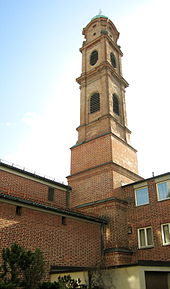Herzogspitalkirche (Munich)
The Roman Catholic Herzogspitalkirche St. Elisabeth is an independent convent church (monastery church) of the Munich Servitinnen .
location
The Herzogspitalkirche (Herzogspitalstrasse 7) is located relatively in the middle of the hospital set up by Duke Albrecht V in the Hackenviertel of Munich's historic old town .
history
Duke Albrecht V had a hospital set up for his court staff in 1555, which was called the Herzogspital . Heinrich Schöttel's plans already envisaged a church in the middle of the ducal hospital, which would be the patronage of “St. Elisabeth ”received. This church, consecrated in 1572, has been the destination of a pilgrimage since 1671 to the much venerated miraculous image of Our Lady of Sorrows. In 1676 the hospital and the church were rebuilt. The ducal hospital was originally founded to accommodate sick court employees and was expanded in the following time. Another of the court's hospitals and supply houses was the neighboring Josephspital in the street of the same name as early as 1626-1632 , also with a church ( Josephspitalkirche ), which has not existed since 1945.
The Servite Convent in the Duke's Hospital, consecrated to St. Elisabeth, was founded in 1715 by Therese Kunigunde of Poland , wife of Elector Maximilian II Emanuel of Bavaria . From 1728, Johann Anton Trubillio, together with master bricklayer Johann Michael Proebstl, built a baroque monastery complex around several courtyards for the hospital's nuns, with an elongated facade facing Herzogspitalstrasse. It was built east of the St. Elisabeth Hospital Church. In 1727 a further baroque reconstruction of the Herzogspitalkirche was inaugurated according to plans by Johann Baptist Gunetzrhainer . The tower was also added in 1727/28.
The hospital, which was under the management of the monastery, was closed in 1800. In 1803, in the course of secularization in Bavaria, the monastery was abolished, but the nuns initially continued to live together.
Especially in the 19th century, Tobias Baader's miraculous image of the Sorrowful Madonna (from approx. 1680) was said to have miraculous effects, so that pilgrimages, penances and thanksgiving services were carried out or celebrated here into the 20th century; the best-known example is Lena Christ . In her biography "Memories of a Superfluous", she describes how, in gratitude for her engagement, she lays flowers on the altar in front of the Sorrowful Mary. The two statues on the choir altar were the work of Andreas Faistenberger . The choir altar sheet by Andreas Wolff depicted St. Elisabeth with an image of the church.
In World War II heavily damaged, the Duke hospital was demolished and replaced by a new building. The tower was renovated, the nave was replaced by a new building based on plans by Alexander Freiherr von Branca in 1956/57, which is characterized by an interior entirely made of brick .
The preserved baroque tower of the Herzogspitalkirche is registered as a monument in the Bavarian list of monuments.
Significant works
- Painful Maria ( Tobias Bader , 1651 ) a valuable wooden figure that was once connected to a cross that was burned in the war (placed in the aisle since 1692). As Maximilian III. Joseph was dying in December 1777, she was taken to his room in the residence during this time.
Remarks
- ^ House of Bavarian History, St. Elisabeth. Retrieved January 9, 2018 .
literature
- Klaus Gallas : Munich. From the Guelph foundation of Henry the Lion to the present: art, culture, history . DuMont, Cologne 1979, ISBN 3-7701-1094-3 (DuMont documents: DuMont art travel guide).
Web links
Coordinates: 48 ° 8 ′ 14.5 ″ N , 11 ° 34 ′ 3 ″ E


